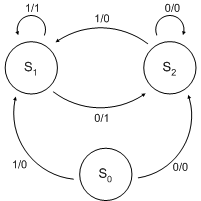I’m using Kinopio to brainstorm some software dev tasks, and had the following thought: being able to connect a card to itself would enable the creation of informal state diagrams, which would be nice to have. I’m imagining a little loop to/from the card’s terminal, with the arrow animation active. This wouldn’t work with straight connectors, and being able to drag/resize the connection itself would be useful to have (I believe this is being discussed elsewhere).
I’m not familiar , what are informal state diagrams? Could you give me a use case for them?
Wikipedia has a good overview and example: State diagram - Wikipedia. I find that they can be particularly useful for mapping out the behaviour of an abstract machine (e.g. an interpreter).
Here’s an example pulled out of a private space: Kinopio – Thinking Canvas. It’s probably inscrutable without context, but that’s the sort of thing I’m doing.
instead of referencing a card to itself, representing each state as a different card seems clearer. It’s also what that wikipedia article does
. the kinopio equivalent of this might be to use tags for the ‘entry action’ part
Sure, representing each state as a card has been my approach. However, a state can transition to itself — consider the “consuming whitespace” state of a lexer or parser.

In this example S1 and S2 can transition to themselves.
If using connections as transitions, this can’t be represented. I can create multiple cards for a given state:

but it’s quite noisy.
in the short term i’d recommend using a blank card to complete self referencing connections. I’ll consider this for the future too, pending more ppl requesting this
